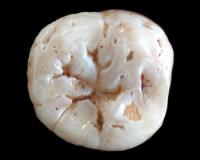
The 40,000-year-old Neanderthal tooth that has given scientists the first direct evidence that Neanderthals moved from place to place during their lifetimes. A 40,000-year-old tooth has provided scientists with the first direct evidence that Neanderthals moved from place to place during their lifetimes. In a collaborative project involving researchers from the Germany, the United Kingdom, and Greece, Professor Michael Richards of the Max Planck institute for Evolutionary Anthropology in Leipzig, Germany and Durham University, UK, and his team used laser technology to collect microscopic particles of enamel from the tooth. By analysing strontium isotope ratios in the enamel - strontium is a naturally occurring metal ingested into the body through food and water - the scientists were able to uncover geological information showing where the Neanderthal had been living when the tooth was formed (Journal of Archaeological Science, February 11th, 2008).
The tooth, a third molar, was formed when the Neanderthal was aged between seven and nine. It was recovered in a coastal limestone cave in Lakonis, in Southern Greece, during an excavation directed by Dr Eleni Panagopoulou of the Ephoreia of Paleoanthropology and Speleology (Greek Ministry of Culture). The strontium isotope readings, however, indicated that the enamel formed while the Neanderthal lived in a region made up of older volcanic bedrock. The findings, published in the Journal of Archaeological Science, could help answer a long-standing debate about the mobility of the now extinct Neanderthal species.
Some researchers argue that Neanderthals stayed in one small area for most of their lives; others claim their movements were more substantial and they moved over long distances; and others say they only moved within a limited area, perhaps on a seasonal basis to access different food sources.
Professor Richards said: "Strontium from ingested food and water is absorbed as if it was calcium in mammals during tooth formation. Our tests show that this individual must have lived in a different location when the crown of the tooth was formed than where the tooth was found. The evidence indicates that this Neanderthal moved over a relatively wide range of at least 20 kilometres or even further in their lifetime. Therefore we can say that Neanderthals did move over their lifetimes and were not confined to limited geographical areas."
"Previous evidence for Neanderthal mobility comes from indirect sources such as stone tools or the presence of non-local artefacts such as sea shells at sites far away from the coast. None of these provide a direct measure of Neanderthal mobility." said Dr Katerina Harvati of the Max Planck Institute, in Germany, who initiated the study.
The researchers believe the laser ablation technique used to collect the minute particles of enamel will allow the measurement of other rare Neanderthal remains to see how the result compares in other regions and at other time periods.
The technique could also allow scientists to look at very small scale migrations, which is not possible with traditional research methods, and could possibly be applied to research into early humans.
Source : Max-Planck-Gesellschaft
 Print Article
Print Article Mail to a Friend
Mail to a Friend
